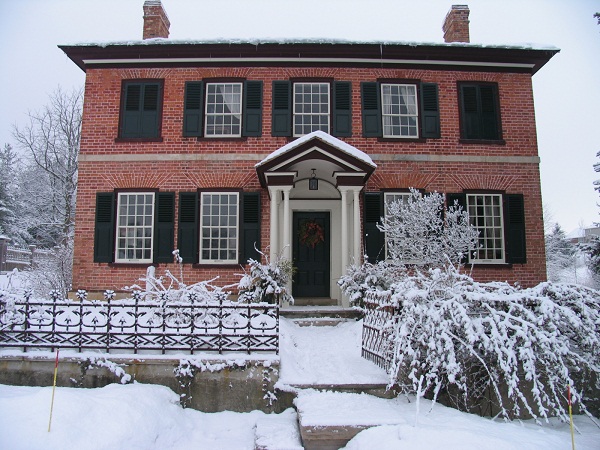TORONTO- Five years ago, a Group of provincial Masonry experts selected its top masonry heritage buildings in the Kitchener-Waterloo, Cambridge region in conjunction with the North Waterloo Region Branch of the Architectural Conservancy of Ontario. These buildings that define Kitchener-Waterloo (K-W) and Cambridge are known for their distinctive beauty, history and longevity.

With an enduring presence that shapes the landscapes on which they were built, these heritage buildings were selected by industry experts as the finest examples of masonry design in the tri-cities of southern Ontario. “Heritage buildings made of brick, block or stone are the longest lasting and most architecturally significant designs in any community,“ says Jack Prazeres, President of MasonryWorx. “Landmarks like these move people with their iconic beauty.”
Prazeres went on to say, “Often built with locally quarried stone and clay for brick, many of these buildings not only define their communities through their design but also their material – they are true reflections of the geography on which they stand.”
The yellow-hued brick for example is a hallmark of this region that creates a sense of place like no other part of Ontario. The yellow-coloured brick comes from calcium rich clay mixed with limestone from the Niagara escarpment.
“Although none of our top masonry heritage buildings used the yellow brick, because in the past it was not considered as high quality as red brick, the yellow brick deserves honourable mention for the regional distinctiveness it has created,” Prazeres says. “There is no doubt however that this regional brick has stood the test of time and has helped define Waterloo Region.”

The criteria used to choose the top buildings included: durability, aesthetic appeal, craftsmanship, and the best use of masonry products in their architectural design.
After a panel discussion by masonry professionals working with brick, block and stone, MasonryWorx selected the following five Kitchener-Waterloo and Cambridge buildings to honour for their masonry heritage value:
Galt Collegiate Institute – This Cambridge landmark was founded in 1852, when it was known as the Galt Grammar School, a highly reputable private school for boys. Today, the symmetrical building designed in the Scottish Baronial style houses a public secondary school. The building, which is constructed from fossilized limestone quarried from on-site riverbanks, underwent several additions between 1859 and 1923.
Gore Mutual Insurance Company head office — The 1935 Neoclassical Revival head office of the historic Gore Mutual Insurance Company in Cambridge features impressive exterior fieldstone walls and a beautiful interior finished in at least four types of marble and locally supplied granite. Stunning features of marble and fieldstone also grace the 1955 addition to the building.
Wilfrid Laurier University, Lyle S. Hallman Faculty of Social Work– First known as St. Jerome’s College, the two buildings on this property in Kitchener were built in 1907 and 1909. The buildings are handsome and well-preserved examples of Neo-Classical architecture. The features of the 1907 Duke St. building include the monumental central pavilion with pediment, coupled columns, front entrance, window openings and brickwork. Features of the 1909 College St. building include the brickwork and window openings.
http://www.downtownkitchener.ca/news/wilfrid_laurier_faculty_social/
Walper Hotel – A parade of notable guests from Eleanor Roosevelt and Louis Armstrong to Pierre Trudeau and Lady Gaga have dined and slept at this hotel at King and Queen Streets in Kitchener. Established in 1893, the building cost just $75,000 to build. Guests could have a room, three meals a day, a pitcher of water, gas lamp lighting, a spot to hitch their horse and use of one of the hotel’s common area bathrooms for just $4.50 per week. With its delicate brickwork over the arched windows and elegant cornices, it is the city’s best example of hotel architecture.
http://www.walper.com/the_hotel.html
Wissler-Cascaden House The simple Mennonite Georgian style popular with Pennsylvanian settlers inspired the design of his two-storey house in Waterloo. It was built in 1842 by John Wissler, a pioneer from Lancaster County, Pennsylvania. He helped establish the hamlet of Lexington thanks to his tannery and the many businesses and trades that sprouted up to support it. The current owners have given a great deal of time, effort and care to the extensive restoration of the house which portrays a faithful representation of early Waterloo. For the Silo, Vickie Fagan.
http://www.historicplaces.ca/en/rep-reg/place-lieu.aspx?id=10658

Supplemental- MasonryWorx is the trade association of brick, block and stone masonry industry professionals. Its membership includes product manufacturers, suppliers and skilled professionals from across Ontario, and the organization is committed to providing home buyers, homeowners, architects, engineers, builders and government leaders with accurate, timely information about the use and benefits of brick, block and stone products.
Lady Gaga, is an American singer, songwriter, record producer, activist, businesswoman, fashion designer and actress. Born and raised in New York City, she primarily studied at the Convent of the Sacred Heart and briefly attended New York University’s Tisch School of the Arts before withdrawing to focus on her musical career. She soon began performing in the rock music scene of Manhattan’s Lower East Side.
By the end of 2007, record executive and producer Vincent Herbert signed her to his label Streamline Records, an imprint of Interscope Records. Initially working as a songwriter at Interscope Records, her vocal abilities captured the attention of recording artist Akon, who also signed her to Kon Live Distribution, his own label under Interscope. Brandie Berkman
Hi, i have reading out and i will definitely bookmarrk your site, just wanted to say i liked this article.